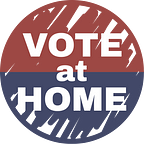Voters say they’ll continue voting at home. Are we prepared?
Election officials put in tremendous effort to administer safe and secure elections throughout 2020. This effort included dramatically scaling up operations, providing voters with multiple return options (e.g., drop boxes, satellite offices), and expanding early voting days and hours — all of which resulted in record numbers of voters choosing to vote at home and early in-person.
However, election officials’ work continues year-round. Election officials across the U.S. are beginning to plan and budget for future elections, and it is a tall task at a time when there is significant uncertainty about whether 2020 will be an anomaly or a new normal.
One thing is certain, however: the 2020 surge of people voting at home and early will not be a one-time event. In survey after survey, voters have made their intentions known — they want to continue voting at home and early in person.
Voting at home was a new experience for some voters; some voted at home for the first time due to increased access to mail ballots in their jurisdiction and some due to more education about existing mail ballot options. The vast majority say they will continue:
- In an MIT Election Lab survey, 81% of respondents who voted at home in 2020 say they’re “very likely” or “somewhat likely” to repeat.
- In our polling, 70% of respondents who voted at home in 2020 say that voting at home is their preferred voting method.
- Voters are also likely to continue voting early in-person. In our polling, 80% of respondents who voted early in-person in 2020 say it’s their preferred voting method.
This is not new. In states such as Oregon and Utah that have long provided voters with options, voters continued to adopt these options over time because of their convenience, accessibility, and security.
So how can election officials (and legislators) prepare?
- Publicly support policies to retain last year’s expanded options for voting early and at home. Measures that allowed no-excuse absentee voting kept voters safe while reducing lines and operational challenges at polling places in 2020. Making these changes permanent would provide certainty and convenience for voters — and more consistent operating conditions for election officials.
- Budget and plan for continued voting at home after the pandemic recedes. From staffing and vendor management to facilities and processing equipment, election administration will remain a critical area in need of investment. Policies may change, but voter intent is sure to stay high.
- Debrief the 2020 experience to improve processes. Draw on feedback from voters, staff, and poll workers to understand what worked well and what could be improved. As an organization started by former election officials for election officials, NVAHI can provide resources to assist with operational planning and voter communication.
Interested in partnering on elections research or reviewing survey data? Reach out to info@voteathome.org.
